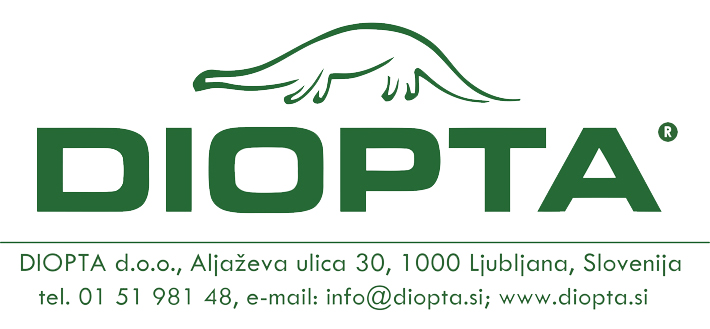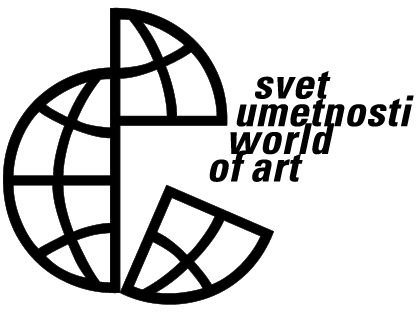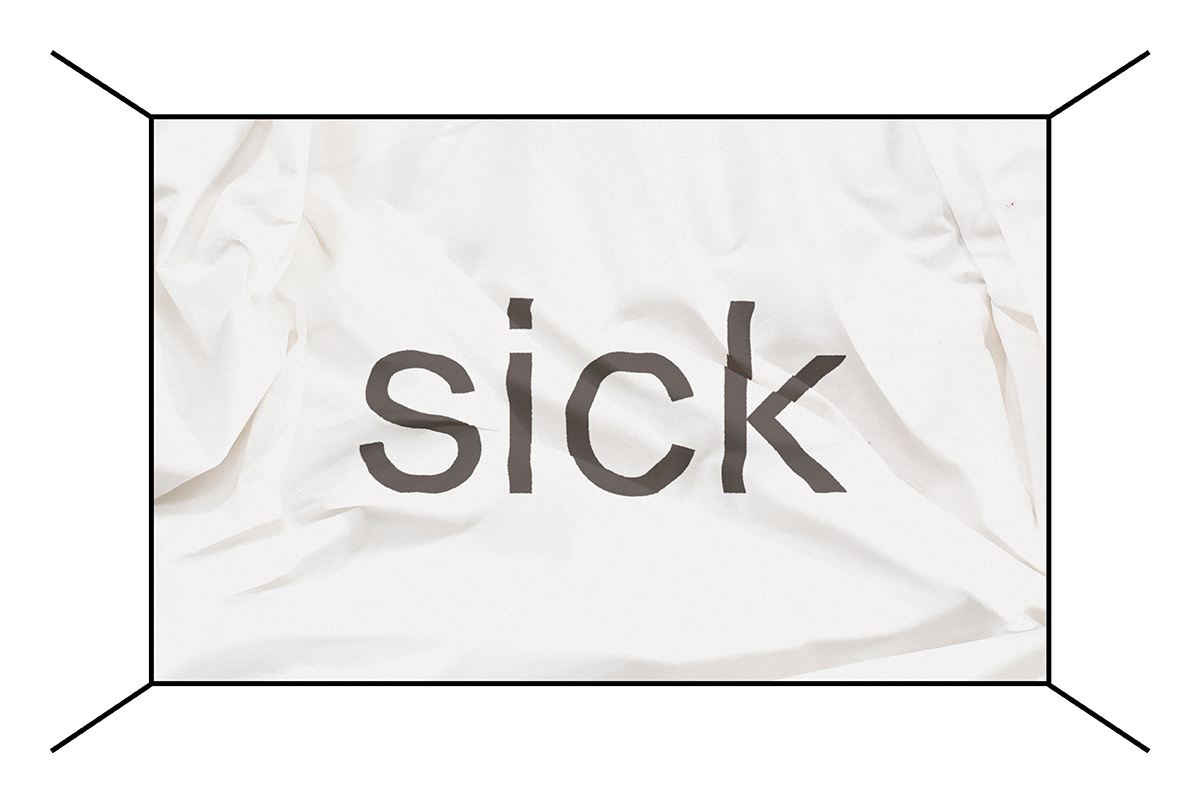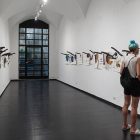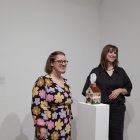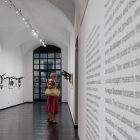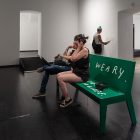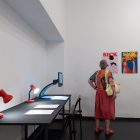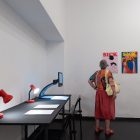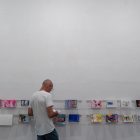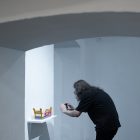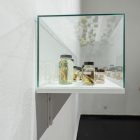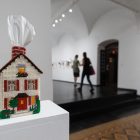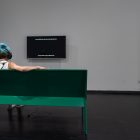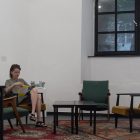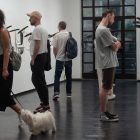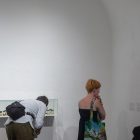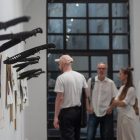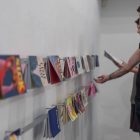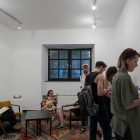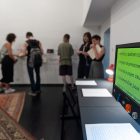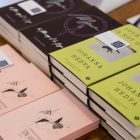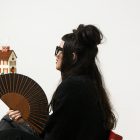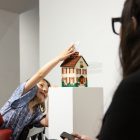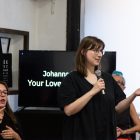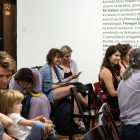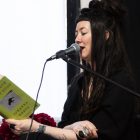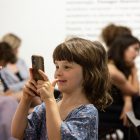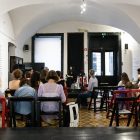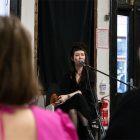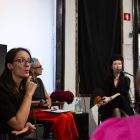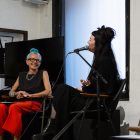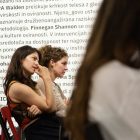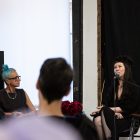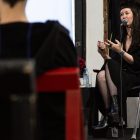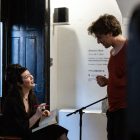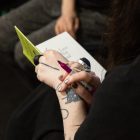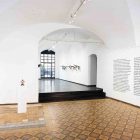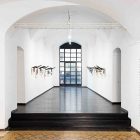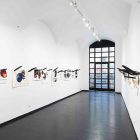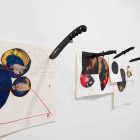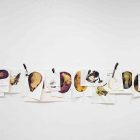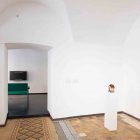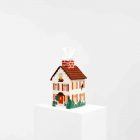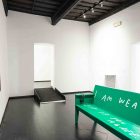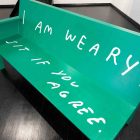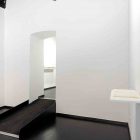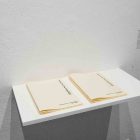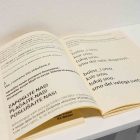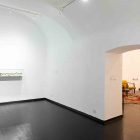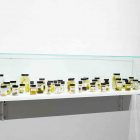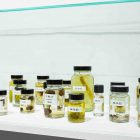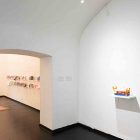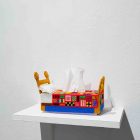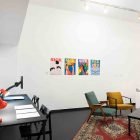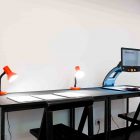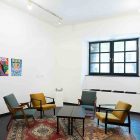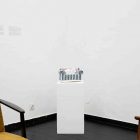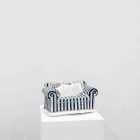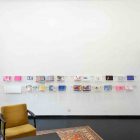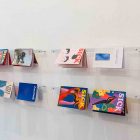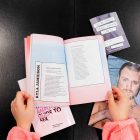Sick
The annual exhibition of the School for Curatorial Practices and Critical Writing World of Art
21 June – 18 July 2023
Škuc Gallery, Stari trg 21, Ljubljana
Exhibition opening: Wednesday 21 June 2023, 7 pm
Artists: Johanna Hedva, Finnegan Shannon, Olivia Spring (SICK Magazine), RA Walden
Curators: Urška Aplinc, Lara Plavčak
Advisory role and assistance: Vesna Bukovec, participants of the 19th generation of the School for Curatorial Practices and Critical Writing World of Art Jernej Čuček Gerbec, Lin Gerkman, Lara Nagy, Isidora Todorić, Lara Zupan
Image description: Photo of a white crumpled bed sheet with the word sick written in grey lower-case letters. The inscription follows the folds of the sheet. The photo is surrounded by a frame made of a thin black line and a white border.
23 June at 6 pm: Viewing of the exhibition for people with blindness and visual impairments with teacher of people with visual impairments Peter Rot (Inter-Municipal Association of the Blind and Visually Impaired Nova Gorica) – in Slovenian.
29 June at 6pm: Book presentation Your Love Is Not Good and conversation with the author Johanna Hedva – in English, accompanied by an interpreter for Slovenian sign language. Moderator: Suzana Tratnik. Co-organised by: Azil Bookstore (ZRC SAZU).
7 July at 6pm: Viewing of the exhibition with the curators – in Slovenian, accompanied by an interpreter for Slovenian sign language.
13 July at 6pm: Lecture by Amanda Cachia Contemporary Disability Art: Accessibility Aesthetics and Institutional Critique – in English, accompanied by an interpreter for Slovenian sign language, equipped with English subtitles. The lecture will take place via Zoom, registration at: info@scca-ljubljana.si.
18 July at 6pm: Final viewing of the exhibition with the curators – in English.
The exhibition Sick features works by artists who identify as disabled and/or chronically ill and thus wishes to bring the experience of illness and disability,[1] often associated with the private, into the public sphere. The exhibition includes works by international artists Johanna Hedva, Finnegan Shannon and RA Walden, as well as a reading room curated by writer Olivia Spring. In their practice and artworks, the artists explore the lived experience of illness/disability as that nexus of class, race and gender that is usually overlooked in discussions of intersectionality[2] and political activism.[3]
It is unpleasant to think that we will all become sick or disabled at some point. Non-disabled[4] individuals and society collectively brush aside the thought of the inevitable, and at the same time also all those who are already facing it. The fear is not surprising, since capitalism equates the value of people with their productivity and the possibility of (ab)using their bodies for the purpose of capital. Meanwhile, it is pushing the disabled and the sick into poverty, and with the decline of social security, vulnerable groups are becoming even more invisible to the rest of society. Disability is a concept of the lived experience in an ableist[5] society and the individual’s embodiment, not medical diagnosis and legal definition.[6]
Embodiment in late capitalism is explored by RA Walden. In the work Crip Ecologies, the fragility of the body is tied to the fragility of our ecosystems. The installation archives the artist’s limited contact with nature, which is the result of their disability. Natural objects are preserved in alcohol in containers that resemble apothecary bottles. They seem mundane, even self-evident but are elevated as precious artefacts in the work. The booklet and video Notes From The Underlands form a performative text about the queer utopia of the disabled and the sick. By calling to action and reflecting on the relationship of people who are not-yet-disabled in relation to the community of the disabled and sick, they challenge the assumption that the body must be physically present (and non-disabled) in order to perform. Both works explore manifestations of care that go beyond binary understandings of non-disability and disability, sickness and health.
Johanna Hedva connects the practices of care with queer feminism, alternative knowledge systems and self-organisation. The Medusa and the Snail[7] is a material, an almost visceral investigation of corporeality interwoven with alternative knowledge, culture and ancestral knowledge, intuition and dreams. For the viewer, the claustrophobic installation provokes an awareness of their own body in space. The artist and writer in their practice also otherwise interweaves mysticism, rituals and themes related to sickness, disability, marginalisation and mutual care.
But care must also become the responsibility of institutions, including cultural ones. The working principles of contemporary art institutions rarely allow for the possibility of including people with disabilities/chronic illnesses, both artists and audiences. Ableist institutions, with their hyperproduction of projects, do not envisage operating on crip time.[8]. In an equal relationship between the artist and the institution (the individual within the institution), the artist’s access rider[9] can be an open dialogue of necessary and possible adjustments. The focus on accessibility, especially when seen as an intellectual and creative challenge, is transformative for the medium of the exhibition and the exhibition programme.
Artist Finnegan Shannon’s interventions create accessibility in physical and digital spaces. By placing benches with text as artworks in gallery spaces, they draw attention to the neglect of the basic physical needs of people with disabilities, while at the same time putting the solution into practice.[10] The seating offers visitors a place to rest and a chance to listen to their bodies. It also provides an opportunity to interact with other works – the bench For RA Walden’s Notes From Underlands is set up for viewing RA Walden’s video. Sitting becomes a gesture of protest and one of the incentives for public space to recognise the needs of different bodies, not just normative ones. The artist deals with the private experience of illness and disability in three works, embroidered tissue boxes in the shape of a house A little pleasure for you, a sofa A little softness for you and a bed A little comfort for you. With them, they recall experiences from the lives of disabled or sick individuals, connected to the home and the private, marked by pain and the need to take care of oneself and others. The tissues and their boxes are an object of consolation that invites us to reflect on our care roles and to accept our interdependence.
In the absence of care structures, online communities have formed on social networks to support, educate and bring together. Self-publishing activities are also part of these communities, above all (fan)zines as an important medium of expression and networking for groups that are not part of the dominant culture. For the exhibition, writer Olivia Spring, founder and editor of SICK Magazine, a magazine by disabled and sick authors, has compiled a selection of zines, magazines, poems, anthologies and books covering a range of perspectives on disability and illness. The reading room aims to shake the wilful ignorance of a society that does not acknowledge the experiences and needs of people with disabilities. The duty to raise awareness must be shared and not remain an additional burden borne exclusively by disabled and sick people.
With this exhibition, we seek to place accessibility at the heart of our practice, our working methodology and our exhibition programme. The exhibition presents the different perspectives of artists, art practitioners and communities that create a space to reflect on the issues and connections of disability, art and contemporary society, through which we aim to approach different exhibition strategies for work, connection and inclusion.
______
[1] In Slovenian, appropriate terms around “disability” are not yet fully embraced so words like “invalid” and “handicapped”, which are stigmatising, are still in circulation. We have therefore added the English original and an explanation to the Slovenian as clarification.
[2] See Kimberlé Crenshaw. Intersectionality explains the overlapping sociopolitical systems of power and inequality and the experiences of oppression (or privilege) of people at the axes of these systems.
[3] The political engagement of disabled people is addressed in the essay Sick Woman Theory by Johanna Hedva, in which the resistance of the sick/disabled body is considered.
[4] There is a shift away from the word “abled” in the English language. The term non-disabled indicates that an individual’s psychophysical non-disability is mostly temporary.
[5] Ableism is a system of discrimination and prejudice against people with disabilities. It can also be internalised.
[6] See the social model of disability within disability studies.
[7] The exhibition presents Wart Paintings, which are part of the artwork.
[8] Crip time, see Alison Kafer. It is a non-linear time (and space) experienced by disabled people. Crip comes from cripple, and the word is being reappropriated by some disabled people and groups as an act of empowerment and destigmatisation. The word is not suitable for use by non-disabled persons, except with express consent, if it refers to an individual or a specific group.
[9] A text about the needs of an individual artist for exhibition work, travel, accommodation, live events, etc.
[10] The adaptations, which are primarily designed for disabled people, also benefit non-disabled users. For example elevators and ramps for prams.
Finnegan Shannon, A little comfort for you, 2021
Finnegan Shannon, A little softness for you, 2022
Finnegan Shannon, A little pleasure for you, 2020
Finnegan Shannon explores the private experience of illness and disability in three works, embroidered tissue boxes shaped as a house, a sofa and a bed. With them, they recall experiences from the lives of disabled or sick individuals, connected to the home and the private, marked by pain and the need to take care of oneself and others. The box in the shape of a house is even the same as the one on the artist’s bedside table. They carefully make the covers using pre-made vintage embroidery kits. Embroidery is a handmade craft that we usually associate with domestic, traditionally feminine tasks. Also gendered and associated with private is care work.
In the gallery, these everyday objects, primarily conceived as humorous decor, are exhibited as sculptural objects. The artist creates a gesture of care and offers, at least temporarily, a sense of understanding and safety in a public space where crying and vulnerability are not normally welcome. The tissues and their disguises are an object of consolation that invites us to reflect on our care roles and to accept our interdependence. Caring is or is yet to be, everyone’s task.
_______________
RA Walden, Notes From The Underlands, 2019, 10’17’’
The video Notes From The Underlands is a poetic performative text about the queer utopia of the disabled and the sick. It asks the not-yet-disabled individuals to rethink their relationship with the community of people with disabilities and illnesses. The work points out that sooner or later, we will all be disabled or sick, even if we find it hard to admit. Therefore, we must listen to the disabled and the sick, their needs, experiences and knowledge now, immediately. Only in this way will we learn to care for them and ultimately ourselves and each other.
The video is accompanied by a booklet of the same title, which visitors can take home. Through the performative text in the video, sound, subtitles and print in the booklet, the work problematises the assumption that the body must be physically present (and non-disabled) in order to perform. With the manifesto, the artist reflects on care as an essential part of a future society where binary understandings of disability and ability, illness and health are transcended. The computer-generated voice in the video speaks of a future that the artist spatially indicates as underlands – a land of unsown areas, swamps and new fertility. It is a new time and space where the disabled, forgotten and excluded bodies can form a community of accessibility.
_______________
Finnegan Shannon, For RA Walden’s Notes From The Underlands, 2023
Artist Finnegan Shannon’s interventions create accessibility in physical and digital spaces. By placing seating as artworks in gallery spaces, they draw attention to the neglect of the basic physical needs of visitors, while already putting a solution into practice. A bench with the inscription “I’m weary. Sit if you agree.” is positioned in the gallery opposite RA Walden’s video so we can watch it seated. The bench offers visitors a place to rest and an opportunity to come into contact with other artworks in the exhibition. At the same time, it is one of the incentives for public space to recognise the needs of different bodies, not just normative ones.
A similar project is the series Do you want us here or not, which has been developed since 2018. Benches, chairs or cushions with inscriptions unobtrusively talk to tired visitors of museum and gallery spaces, inviting them to rest. For instance, “This exhibition has asked me to stand for too long. Sit if you agree.”, “I’d rather be sitting. Sit if you agree.”, “I focus better seated. Sit if you agree.”, “It was hard to get here. Rest here if you agree.”, “Museum visits are hard on my body. Rest here if you agree.”
The bench was created with the purpose of viewing the work Notes From The Underlands at the exhibition Sick. The message of the sign is the artist’s reaction to the experience of watching the video, and the style of the handwritten text is their reaction to the qualities of the audio in it. The bench is a different colour from the previous interventions, which were dark blue and white. Its green colour is reminiscent of American road signs for direction and location – as a nod to the instructions provided by the manifesto text of RA Walden’s video.
The artist’s interventions are created precisely with the desire for their works to be experienced by people with disabilities. Ableism functions, among other things, by isolating disabled people and convincing them that their needs are a matter of personal/private experience. Creating connections between people with disabilities is, therefore, a political gesture for the artist. Connections in physical and digital space create space for activism as well as disabled joy.[11]
Bench production: Fabrikaid
______
[11] Disabled joy is the happy feeling of community, authenticity, mutual understanding, acceptance and support. It is a counterbalance to the mass portrayal of disability as something exclusively negative, sad, fatal.
_______________
RA Walden, Crip Ecologies, 2023
Crip Ecologies archives the artist’s limited contact with nature, which is the result of their disability. Objects from nature, such as seed pods, twigs, snail shells, flowers, etc., are preserved in alcohol and placed in containers that resemble apothecary bottles. Such and similar objects often seem mundane, even obvious, but in the work they are elevated into precious artefacts, worthy of special attention. By carefully archiving, sorting and preserving, the artist reflects on the value of objects that are becoming increasingly inaccessible to us all due to the biodiversity loss and the climate crisis.
When we talk about ecology today, we rarely think about disabled bodies. However, disabled people are more often exposed to dangerous and poor living conditions, or face the pollution and toxicity of our environments. Both living in environmentally deprived areas and living with disability or illness are connected to lower social class and poverty. Disability and poverty even mutually reinforce each other in the absence of support structures. Incorporating the perspectives of the disabled into thinking about ecology is thus essential, as this sheds light on our general vulnerability and the inaccessibility of our environments. In Crip Ecologies the artist links the fragility of the body to the fragility of ecosystems, highlighting the importance of collective care, interdependence and responsibility for our environments and each other.
_______________
Johanna Hedva, The Medusa and the Snail, 2023
The Medusa and the Snail is a material, an almost visceral investigation of corporeality interwoven with alternative knowledge, culture and ancestral knowledge, intuition and dreams. The associative work builds a constellation of connections whose rules are shaped by jigi 지기 – non-linear time, hauntedness, incompleteness, paradoxes and the unknown. In Korean, jigi 지기 refers to a state of heightened sensitivity to one’s ancestors and the need to commune with the dead, often causing physical pain, nightmares, and intense, prophetic emotions and visions. The work’s title is taken from a 1974 book by the biologist Lewis Thomas, in which he writes, among other things, about the understanding of the notion of selfhood, which is present in all living things, especially in warts.
The series presented at the exhibition Wart paintings is part of a larger art project The Medusa and the Snail. The works on paper are created simultaneously with other projects the artist is making in an interdependent conversation of convergences. When an idea or thought seems strange, Hedva turns to drawing to give it a form and yet, at the same time, make it even stranger. In their materiality, Wart paintings are reminiscent of organisms, galaxies and secretions – sentient warts that we usually see as foreign to us. Sickly formations of various shapes, seemingly with their own agency, as they materialise and move in peculiar ways around and between bodies.
They are mounted on the walls with knives roughly stabbed through the bodies of warts. The knives here, and the thrust that requires them to make a mark, recall any number of experiences of the various violences that fragile bodies withstand in sociality. Thus, they form a claustrophobic installation that can provoke the viewer’s awareness of their own body in the space and make them reflect on their experiences of pain and unfamiliarity.
_______________
READING ROOM
In the absence of necessary care structures, sick and disabled people have turned to online communities to form social networks that provide support, education and solidarity. Self-publishing through zines, magazines, artist books and more is an essential part of these communities, providing an important medium of expression and networking for groups that are not part of the dominant culture.
For the exhibition, writer Olivia Spring, founder and editor of SICK Magazine, a magazine by disabled and chronically ill artists, poets and writers, has compiled a selection of zines, magazines, anthologies and poetry collections for the exhibition, covering a range of perspectives on disability and illness. Publications include copies of SICK Magazine, Ache, Lassitude, Able zine, Look Deeper, Bed zine, Sick Of It, I Felt That as well as A Queer Anthology of Sickness. The reading room also features works by Sabrina Simms, Mick Moran, Olivia Spring, Travis Chi Wing Lau, Jillian Weise, Amy Berkowitz, Leah Lakshmi Piepzna-Samarasinha, Calla King-Clements and RA Walden.
The reading room aims to shake the wilful ignorance of a society that does not acknowledge the experiences and needs of people with illnesses and disabilities. The duty to raise awareness must be shared and not remain an additional burden borne exclusively by people with disabilities or illnesses. Visitors are encouraged to relax and take a moment to themselves. This is why the reading room is conceived as a comfortable, peaceful and quiet space. You are kindly invited to follow the featured writers, poets and publishers on social media and continue supporting their work.
Magazines
SICK
IG @aSICKmagazine
IG @OliviaLSpring
IG @KaiyaWaerea
Ache
IG @helloachemagazine
TW @ache_magazine
Lassitude
IG @lassitudezine
Able zine
IG @ablezine
IG @lilguerrera
Look Deeper
IG @lookdeeperzine
IG @elliedarbyprangnell
Bed zine
IG @bed_zine
IG @tash___king
Zines
Being Chronically Ill Sucks, Sabrina Simms
IG @starlyartstudio
Sick Of It
IG @fierce_invalids
TW @fierce_invalids
Lazy, Mick Moran
Let me know if there’s anything I can do, Mick Moran
IG @micklikestype
Collapse, Olivia Spring
IG @OliviaLSpring
Anthologies
A Queer Anthology of Sickness
IG @pilotpresslondon
TW @pilotpressldn
I Felt That
IG @helloachemagazine
TW @ache_magazine
IG @procrastinarting_
Poetry & other
Paring, Travis Chi Wing Lau
IG @travisclau
TW @travisclau
The Amputee’s Guide to Sex, Jillian Weise
jillianweise.com
Tender Points, Amy Berkowitz
IG @helloberko
TW @mondobummer
Toungebreaker, Leah Lakshmi Piepzna-Samarasinha
IG @leahlakshmiwrites
Walls, Calla King-Clements
IG @callakc.art
A Primer on Working With Disabled Group Members for Feminist / Activist Groups and Organisations, RA Walden
Book I/IV: Lexicon (subgroups), RA Walden
Book II/IV: Lexicon (ẍây ithřa to English), RA Walden
Book III/IV: Lexicon (English to ẍây ithřa), RA Walden
Book IV/IV: Grammar + Bibliography, RA Walden
rawalden.com
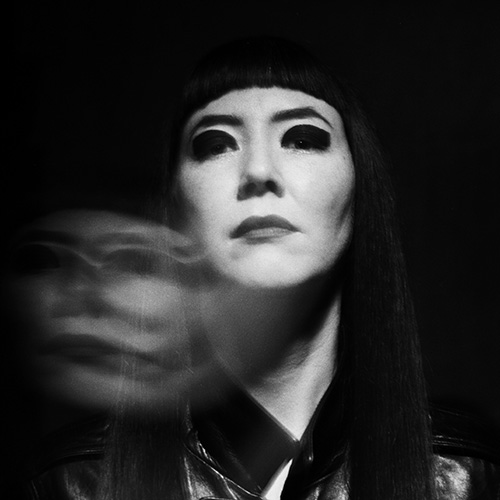 Johanna Hedva (KOR/USA/GER) is a writer, artist and musician. Their work explores grief, death, illness, disability, mysticism and ritual through language. They have exhibited at the Gropius Bau, Haus der Kulturen der Welt, Institute of Contemporary Arts, Gyeongnam Art Museum and LA Architecture and Design Museum. Their texts have been published in Triple Canopy, The White Review, frieze and Topical Cream, among others. (Photo: Ian Byers-Gamber)
Johanna Hedva (KOR/USA/GER) is a writer, artist and musician. Their work explores grief, death, illness, disability, mysticism and ritual through language. They have exhibited at the Gropius Bau, Haus der Kulturen der Welt, Institute of Contemporary Arts, Gyeongnam Art Museum and LA Architecture and Design Museum. Their texts have been published in Triple Canopy, The White Review, frieze and Topical Cream, among others. (Photo: Ian Byers-Gamber)
Image description: Black and white portrait of a white person where an apparition of their face hovers to the lower left, connected by a trail of pneuma. (Image description prepared by Johanna Hedva.)
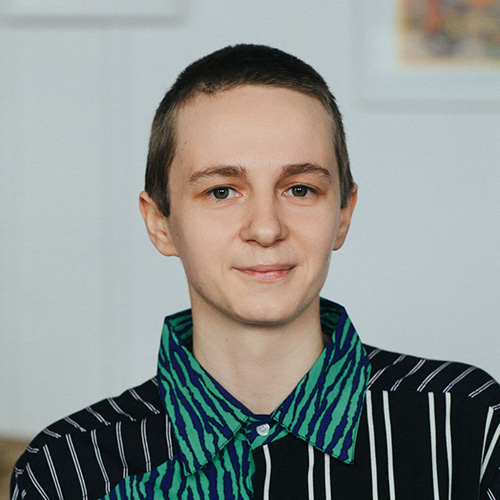 Finnegan Shannon (USA) is a multidisciplinary artist whose work focuses on disability cultures. They often address barriers (e.g. stairs) and lack of adaptations in institutions with interventions that prioritise accessibility. They have worked with many organisations including the Banff Centre, ARGOS Centre for Audiovisual Arts, Museum of Contemporary Art Denver, MMK Frankfurt, LUX and Deborah Schamoni. (Photo: Sylvie Rosokoff)
Finnegan Shannon (USA) is a multidisciplinary artist whose work focuses on disability cultures. They often address barriers (e.g. stairs) and lack of adaptations in institutions with interventions that prioritise accessibility. They have worked with many organisations including the Banff Centre, ARGOS Centre for Audiovisual Arts, Museum of Contemporary Art Denver, MMK Frankfurt, LUX and Deborah Schamoni. (Photo: Sylvie Rosokoff)
Image description: Bust portrait of a white person with close-cropped hair. With a reserved smile and a shirt with asymmetrical multi-pattern. (Image description prepared by Finnegan Shannon.)
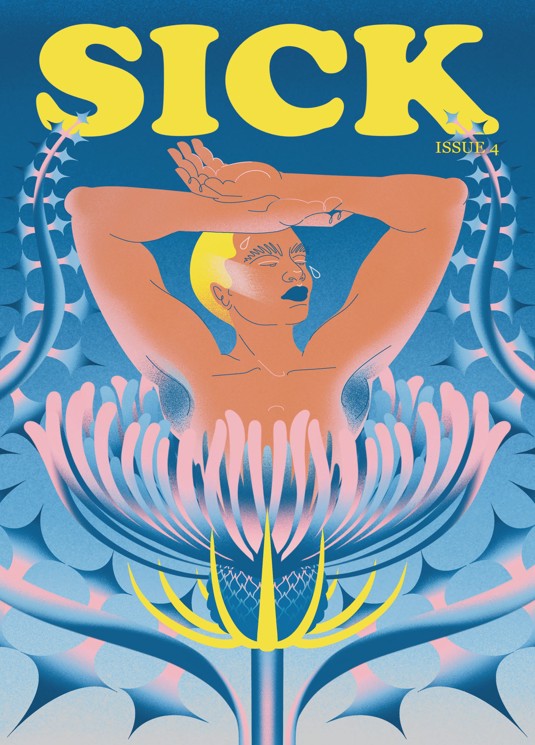 SICK Magazine, an independent international magazine by and for the chronically ill and people with disabilities, was founded in 2019 by Olivia Spring and designed by Kaiya Waerea. The magazine aims to strengthen their representation in publishing and the arts, and to challenge harmful stereotypes and misconceptions about disability. (Photo: cover of issue 4 of SICK Magazine)
SICK Magazine, an independent international magazine by and for the chronically ill and people with disabilities, was founded in 2019 by Olivia Spring and designed by Kaiya Waerea. The magazine aims to strengthen their representation in publishing and the arts, and to challenge harmful stereotypes and misconceptions about disability. (Photo: cover of issue 4 of SICK Magazine)
Image description: Cover illustration features a person with brown skin growing out of a blue and pink thistle. Their arms are resting on top of their yellow hair, and they are looking away with a tear on their cheek and forehead. The blue and pink thorns on the stem of the thistle extend up and around the person, meeting yellow text that says SICK and underneath it, Issue 4. (Image description prepared by SICK Magazine.)
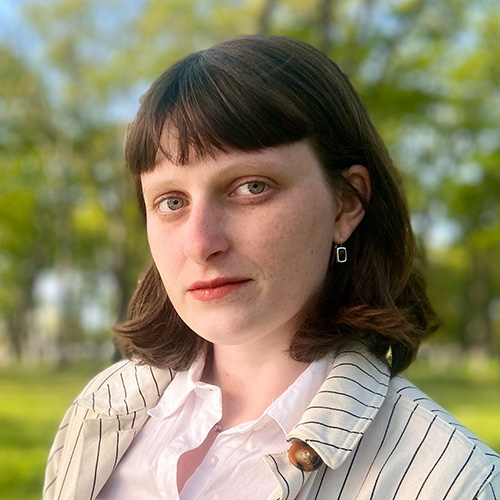 Olivia Spring (USA) graduated from Goldsmiths, London. She is the recipient of the Monson Arts and Hewnoaks residencies, as well as grants from the Andy Warhol Foundation for the Visual Arts Regional Regranting Program and the Indiecon Festival. She writes about illness, trauma and belief, and is currently working on her first book. (Photo: Megan Jones)
Olivia Spring (USA) graduated from Goldsmiths, London. She is the recipient of the Monson Arts and Hewnoaks residencies, as well as grants from the Andy Warhol Foundation for the Visual Arts Regional Regranting Program and the Indiecon Festival. She writes about illness, trauma and belief, and is currently working on her first book. (Photo: Megan Jones)
Image description: Portrait of a young white woman with dark brown hair in shoulder length and bangs standing in front of green trees in a park. She has green eyes. She is wearing a white shirt and a beige blazer with vertical stripes.
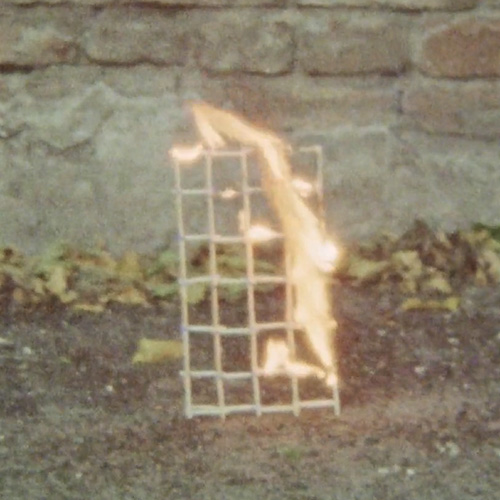 RA Walden (UK/GER) is a transdisciplinary artist who explores a queer disabled perspective on the fragility of the body. Their practice spans sculpture, installation, video, and printed matter, all of which is undertaken with a socially engaged and research-led working methodology. To date, their work has been shown at BALTIC Centre for Contemporary Art, Hebbel Am Ufer, National Gallery of Australia, SOHO20, Kunstinstituut Melly, Storm King Art Centre. They have been a resident of Shandaken Storm King, Wysing Arts Centre, Hebbel am Ufer, and La Becque. (Photo: RA Walden, Structures of Care (Scaffold for Lauryn), 2020, video still)
RA Walden (UK/GER) is a transdisciplinary artist who explores a queer disabled perspective on the fragility of the body. Their practice spans sculpture, installation, video, and printed matter, all of which is undertaken with a socially engaged and research-led working methodology. To date, their work has been shown at BALTIC Centre for Contemporary Art, Hebbel Am Ufer, National Gallery of Australia, SOHO20, Kunstinstituut Melly, Storm King Art Centre. They have been a resident of Shandaken Storm King, Wysing Arts Centre, Hebbel am Ufer, and La Becque. (Photo: RA Walden, Structures of Care (Scaffold for Lauryn), 2020, video still)
Image description: Blurry photo of an uneven, precarious looking scaffold structure made of matchsticks that is on fire. The structure is placed on a dirt floor covered with leaves in front of a cement and brick wall. (Image description prepared by RA Walden.)
Exhibition opening, 21 June 2023
Photo: Simao Bessa © Škuc Gallery
Johanna Hedva presents her book Your Love Is Not Good / in conversation with Suzana Tratnik, 29 June 2023
Photo: Sara Rman © Škuc Gallery
Exhibition view
Photo: Matic Pandel © Škuc Gallery
Visiting
Entry to the exhibition and all accompanying events is free of charge. Škuc Gallery is equipped with a ramp for persons with reduced mobility at the entrance (width 150 cm) and in the space (width 106 cm). The inner courtyard and the toilets of the gallery are not accessible to wheelchair users. Accessible toilets are available in the restaurant Druga Violina next door. Please contact the restaurant staff for assistance. The toilet in the gallery is gender-neutral. Free tap water is available. The reading room, which is part of the exhibition, has comfortable seats with backrests. The gallery is generally a quiet space and the sounds of the artworks are limited to headphones. The gallery is not equipped with a hearing loop. The exhibition text is available in Braille and in print for people with visual impairments (both in Slovenian). A magnifying glass is also available for people with visual impairments. As we want to make the visit to the exhibition safe also for people with compromised immune systems, we recommend the use of protective masks. Dogs are welcome. The staff can provide a bowl of water for them.
Arriving
The nearest bus stop to the gallery is Gornji trg (180 m), where bus lines 2, 3, 11, 19 and 27 stop. More information is available on the LPP website or by calling LPP (+386 1 582 2425, +386 51 449 992). Most buses are equipped with a ramp, but we still recommend that you call LPP to inquire about the accessibility of the bus during your time slot. The gallery is in the pedestrian zone in the centre of Ljubljana. The nearest driveway for cars is 50 m away. The streets in the immediate vicinity are paved. You can catch a ride with the free Kavalir vehicle service in the pedestrian zone, which can be ordered from 6 am to 10 pm by phone (open vehicles: +386 31 666 331, +386 31 666 332; closed vehicles: +386 31 666 299). Vehicles are not accessible for wheelchair users. The nearest payable car park with disabled parking (8) is NUK II. near Emonska cesta (500 m), the nearest disabled car park (1) for short-term parking is at Levstikov trg (100 m). For more information, contact JP LPT (+386 1 300 1200). A map of the accessibility of locations in the centre of Ljubljana and other useful information is also available on the website of the Slovenian Paraplegic Association.
Organisers: World of Art/SCCA-Ljubljana, Škuc Gallery
Partners: Inter-Municipal Association of the Blind and Visually Impaired Nova Gorica, Riso Paradiso, Druga violina
The World of Art school programme is created in partnership with Cukrarna/MGML.
Slovene proofreading: Inge Pangos
English translation: Arven Šakti Kralj
Design and cover image: Lea Jelenko
Acknowledgements: Johannes Beck, Berliner Festspiele/Gropius Bau, Deborah Schamoni, Leandra Busch, Lenka Đorojević, Izidor Bratun, Kino Šiška
Supported by: Ministry of Culture of the Republic of Slovenia, City Municipality of Ljubljana – Department of Culture, ifa (Institut für Auslandsbeziehungen)
Sponsor: DIOPTA, d. o. o., Ljubljana
![]()
![]()
![]()
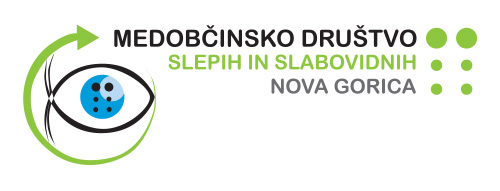
![]()
![]()
![]()
![]()

